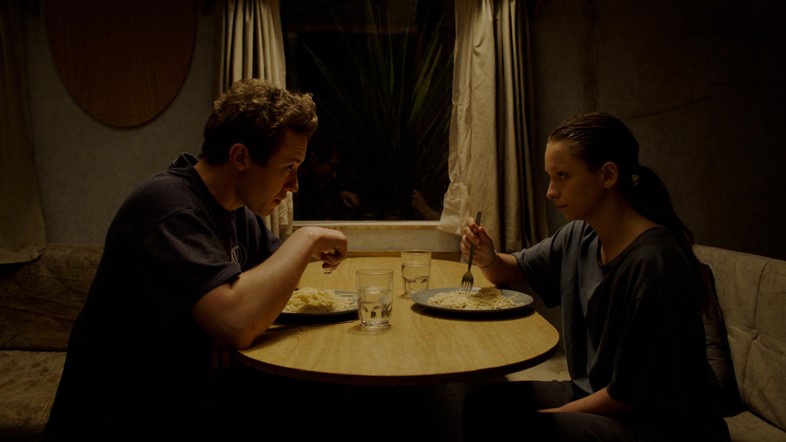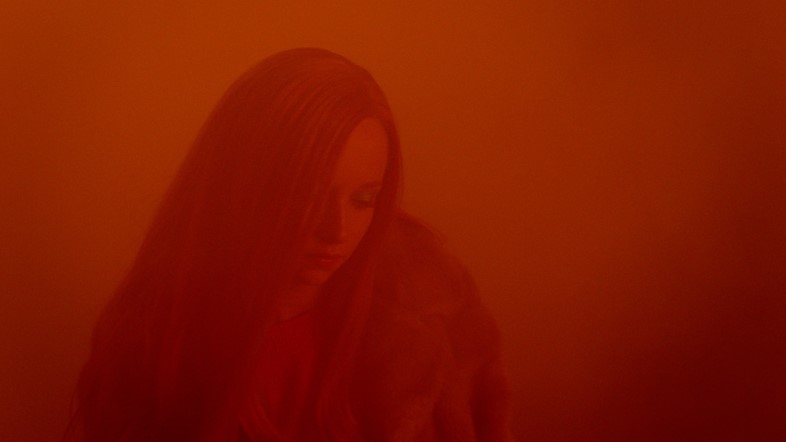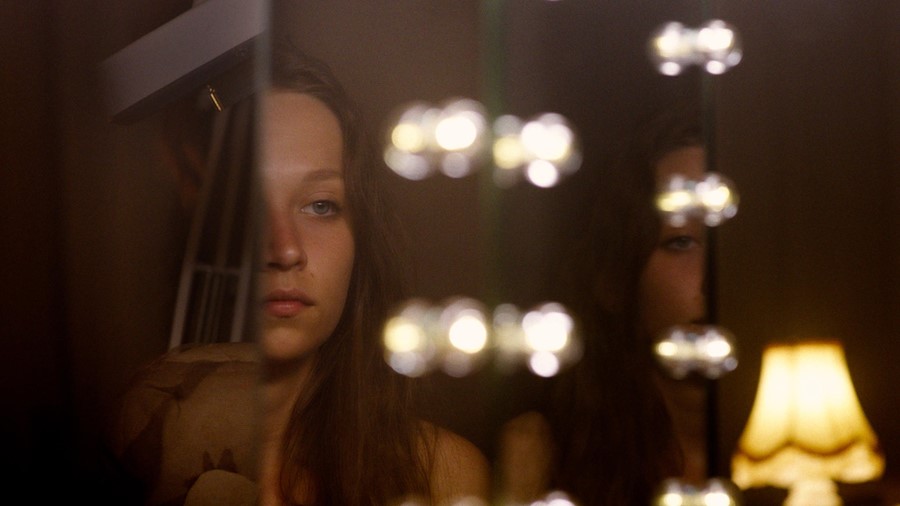Director Claire Oakley speaks on her debut feature film, the powerful and mysterious Make Up
The immaculate, slippery texture of plastic, the sound of twisting winds and the deep, ochre colours of the shoreline pervade Claire Oakley’s debut feature film Make Up and haunt the viewer long after the closing credits. It is a conjuring of a collective disturbance and unsettling miasma which tells a unique story of female sexuality and girlhood, both strange and beautiful.
Oakley’s film has already attracted critical acclaim for its powerful and suggestive storytelling. Filmed just off the north coast of Cornwall and set within a holiday park, we follow Ruth (Molly Windsor) as she starts to come undone, at first suspecting her boyfriend of having an affair and then gradually being drawn towards another young woman whose presence unsettles the very foundations of her reality. Everything begins with a lone red hair found on Ruth’s pillow.

The title of Oakley’s film is especially key to unravelling its mysterious aesthetic. Drawing on the imagery of make-up and lipstick, Oakley extends this as a potent metaphor, hinting at multiple themes in relation to unconscious and repressed desires. In one key sequence, we watch Ruth applying red lipstick, playing with the way she looks; we also see lipstick on textures of glass and mirrored reflections. Oakley describes the film’s title as a “puzzle”, calling attention to the symbolism of make-up: “I use make-up in the film to look at the different ways in which someone might feel about expressions of femininity, but the title also speaks of making-up things, or telling tales, making up or breaking up. Most importantly, ‘making up’ our identity.”
This notion of female identity is further influenced by Maria Lassnig’s paintings, particularly Self-Portrait Under Plastic (1972). Lassnig’s portrait sees her face under a thin film of plastic, loosely falling over her head. Oakley discovered Lassnig’s work while developing the script for Make-Up through iFeatures, a year-long scheme for emerging filmmakers which involves a series of labs. One of these labs was in Liverpool where there was an exhibition of Lassnig’s work: “I was pretty consumed by her work. It’s mostly self-portraits … that picture of her under plastic really struck me as how suffocating it can be to be a woman or express yourself. The picture seeped into my unconscious and surfaced as those images [in the film] of loads of caravans wrapped in plastic. When I’m writing, I collect lots of ideas, I often look at Google Images, and then I write the scene.”

Lassnig’s portrait also evokes the differences between the artificial and the wild, between nature and human nature, in the film. Some of the most evocative sequences in Make Up contain images of sand dunes, the sea and the sound of the wind. This elemental world which Oakley emphasises also extends to “the thick mist and fog”, cultivating a certain kind of “state of mind, governed by your own subjectivity”. The film’s design and lighting also pays a great debt to the work of Todd Hido, an American photographer, who has “created some brilliant images of suburbia and even some caravan parks”.
In addition to the general style of the film, the colour red is used symbolically throughout. Famously, Steven Spielberg picked out the red of a little girls’ coat in Schindler’s List (1993), a film which was otherwise entirely monochrome. Such a use of red also calls to mind the red coat in Nicolas Roeg’s Don’t Look Now (1973), a seminal, almost baroque, horror film about the loss of a child. Oakley’s use of red is a direct response to the British seaside, the alchemy of female sexuality at the heart of her film and the journey Ruth goes on: “The seaside can be bleak and I felt it should have colour to express Ruth’s state of mind. We shot in April so the grass was quite pale, but there were lots of red gas canisters on the site which gave me the idea of only having red emphasised on screen when Ruth feels desire. In this way, the colour red could symbolise something dangerous and exciting. In the grade – during post-production – we made sure all the red popped.”
Indeed, there are some residual traces of the seminal horror film Carrie (1976) and its employment of red as the colour of menstruation. While that film expresses an unconscious, male anxiety towards the female body and female adolescence as a kind of rapture, Oakley’s use of red is about the “mysterious and magical colour of blood”. Going for more of a sociological interpretation of femininity, Oakley researched the behaviour of girls, sitting in the Wellcome Collection in London and “reading about teenagers and desire”.
It is tempting to think about what Oakley might do next and her future certainly seems extremely promising. Next up is a project with the BFI, an adaptation of Laura Kaye’s book, English Animals. There is also “something about the environment set around Kent – the construction of a new town in Kent which is built on an ancient site containing some of the oldest prehistoric remains”.
Make Up is available on Curzon Home Cinema and is screening across the country at selected cinemas. Oakley will also be in further discussion with Davina Quinlivan in September as part of an event at The Freud Museum, London.
